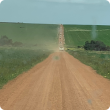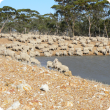Pests, weeds & diseases
Pests, weeds and diseases pose a serious risk for primary producers as they can impact on market access and agricultural production.
To reduce the impact of pests, weeds and diseases, the Department of Primary Industries and Regional Development:
- works with landholders, grower groups, community groups and biosecurity groups.
- provides diagnostic services and information on prevention, management and treatment.
- provides biosecurity and quarantine measures to prevent introduction, and to eradicate or manage current pests.
For advice on pests, weeds and diseases search our website, the Western Australian Organism List or contact our Pest and Disease Information Service (PaDIS).
For diagnostic services, please contact our Diagnostic Laboratory Services.
Filter by search
Filter by topic
- (-) Remove Climate, land & water filter Climate, land & water
- Crops (17) Apply Crops filter
- Livestock & animals (13) Apply Livestock & animals filter
- Biosecurity & quarantine (5) Apply Biosecurity & quarantine filter
- Weeds (4) Apply Weeds filter
- Soils (4) Apply Soils filter
- Grains (4) Apply Grains filter
- Land use (4) Apply Land use filter
- Pests (3) Apply Pests filter
- Pest insects (3) Apply Pest insects filter
- Pastures (3) Apply Pastures filter
- Pasture management (2) Apply Pasture management filter
- Managing soils (2) Apply Managing soils filter
- Pulses (2) Apply Pulses filter
- Livestock management (2) Apply Livestock management filter
- Rangelands (2) Apply Rangelands filter
- Wheat (2) Apply Wheat filter
- Water management (2) Apply Water management filter
- Water (2) Apply Water filter
- Grains research & development (2) Apply Grains research & development filter
- Lupins (2) Apply Lupins filter
- Biosecurity (2) Apply Biosecurity filter
- Barley (2) Apply Barley filter
- Food, export & investment (2) Apply Food, export & investment filter
- Canola (2) Apply Canola filter
- Agribusiness Food & Trade (2) Apply Agribusiness Food & Trade filter
- Diseases (2) Apply Diseases filter
- Climate & weather (2) Apply Climate & weather filter
- Crop weeds (2) Apply Crop weeds filter
- Control methods (2) Apply Control methods filter
- Soil acidity (1) Apply Soil acidity filter
- Oats (1) Apply Oats filter
- Soil constraints (1) Apply Soil constraints filter
- Plant biosecurity (1) Apply Plant biosecurity filter
- Soil productivity (1) Apply Soil productivity filter
- Livestock health & diseases (1) Apply Livestock health & diseases filter
- Water repellence (1) Apply Water repellence filter
- Soil nutrients (1) Apply Soil nutrients filter
- Declared plants (1) Apply Declared plants filter
- Chemicals (1) Apply Chemicals filter
- Biological control (1) Apply Biological control filter
- Crop diseases (1) Apply Crop diseases filter
- Dry seasons and drought (1) Apply Dry seasons and drought filter
- Livestock biosecurity (1) Apply Livestock biosecurity filter
- Feeding & nutrition (1) Apply Feeding & nutrition filter
- Livestock disease surveillance (1) Apply Livestock disease surveillance filter






